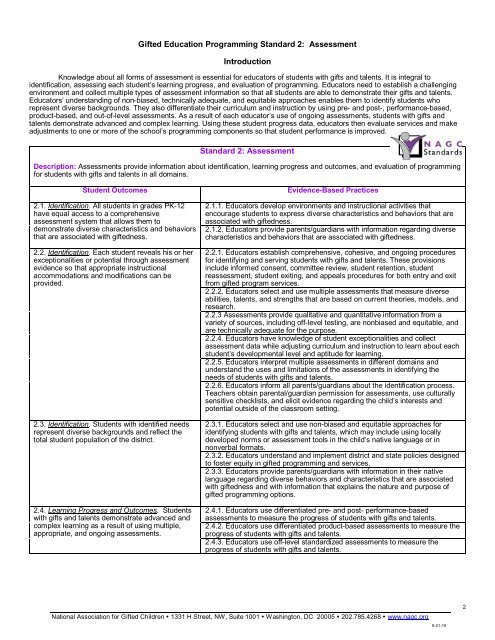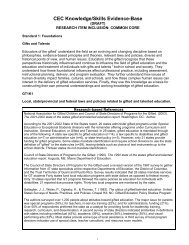2010 Pre-K-Grade 12 Gifted Programming Standards - NAGC
2010 Pre-K-Grade 12 Gifted Programming Standards - NAGC
2010 Pre-K-Grade 12 Gifted Programming Standards - NAGC
You also want an ePaper? Increase the reach of your titles
YUMPU automatically turns print PDFs into web optimized ePapers that Google loves.
<strong>Gifted</strong> Education <strong>Programming</strong> Standard 2: Assessment<br />
Introduction<br />
Knowledge about all forms of assessment is essential for educators of students with gifts and talents. It is integral to<br />
identification, assessing each student’s learning progress, and evaluation of programming. Educators need to establish a challenging<br />
environment and collect multiple types of assessment information so that all students are able to demonstrate their gifts and talents.<br />
Educators’ understanding of non-biased, technically adequate, and equitable approaches enables them to identify students who<br />
represent diverse backgrounds. They also differentiate their curriculum and instruction by using pre- and post-, performance-based,<br />
product-based, and out-of-level assessments. As a result of each educator’s use of ongoing assessments, students with gifts and<br />
talents demonstrate advanced and complex learning. Using these student progress data, educators then evaluate services and make<br />
adjustments to one or more of the school’s programming components so that student performance is improved.<br />
Standard 2: Assessment<br />
Description: Assessments provide information about identification, learning progress and outcomes, and evaluation of programming<br />
for students with gifts and talents in all domains.<br />
Student Outcomes<br />
2.1. Identification. All students in grades PK-<strong>12</strong><br />
have equal access to a comprehensive<br />
assessment system that allows them to<br />
demonstrate diverse characteristics and behaviors<br />
that are associated with giftedness.<br />
2.2. Identification. Each student reveals his or her<br />
exceptionalities or potential through assessment<br />
evidence so that appropriate instructional<br />
accommodations and modifications can be<br />
provided.<br />
2.3. Identification. Students with identified needs<br />
represent diverse backgrounds and reflect the<br />
total student population of the district.<br />
2.4. Learning Progress and Outcomes. Students<br />
with gifts and talents demonstrate advanced and<br />
complex learning as a result of using multiple,<br />
appropriate, and ongoing assessments.<br />
Evidence-Based Practices<br />
2.1.1. Educators develop environments and instructional activities that<br />
encourage students to express diverse characteristics and behaviors that are<br />
associated with giftedness.<br />
2.1.2. Educators provide parents/guardians with information regarding diverse<br />
characteristics and behaviors that are associated with giftedness.<br />
2.2.1. Educators establish comprehensive, cohesive, and ongoing procedures<br />
for identifying and serving students with gifts and talents. These provisions<br />
include informed consent, committee review, student retention, student<br />
reassessment, student exiting, and appeals procedures for both entry and exit<br />
from gifted program services.<br />
2.2.2. Educators select and use multiple assessments that measure diverse<br />
abilities, talents, and strengths that are based on current theories, models, and<br />
research.<br />
2.2.3 Assessments provide qualitative and quantitative information from a<br />
variety of sources, including off-level testing, are nonbiased and equitable, and<br />
are technically adequate for the purpose.<br />
2.2.4. Educators have knowledge of student exceptionalities and collect<br />
assessment data while adjusting curriculum and instruction to learn about each<br />
student’s developmental level and aptitude for learning.<br />
2.2.5. Educators interpret multiple assessments in different domains and<br />
understand the uses and limitations of the assessments in identifying the<br />
needs of students with gifts and talents.<br />
2.2.6. Educators inform all parents/guardians about the identification process.<br />
Teachers obtain parental/guardian permission for assessments, use culturally<br />
sensitive checklists, and elicit evidence regarding the child’s interests and<br />
potential outside of the classroom setting.<br />
2.3.1. Educators select and use non-biased and equitable approaches for<br />
identifying students with gifts and talents, which may include using locally<br />
developed norms or assessment tools in the child’s native language or in<br />
nonverbal formats.<br />
2.3.2. Educators understand and implement district and state policies designed<br />
to foster equity in gifted programming and services.<br />
2.3.3. Educators provide parents/guardians with information in their native<br />
language regarding diverse behaviors and characteristics that are associated<br />
with giftedness and with information that explains the nature and purpose of<br />
gifted programming options.<br />
2.4.1. Educators use differentiated pre- and post- performance-based<br />
assessments to measure the progress of students with gifts and talents.<br />
2.4.2. Educators use differentiated product-based assessments to measure the<br />
progress of students with gifts and talents.<br />
2.4.3. Educators use off-level standardized assessments to measure the<br />
progress of students with gifts and talents.<br />
National Association for <strong>Gifted</strong> Children • 1331 H Street, NW, Suite 1001 • Washington, DC 20005 • 202.785.4268 • www.nagc.org<br />
9-21-10<br />
2
















